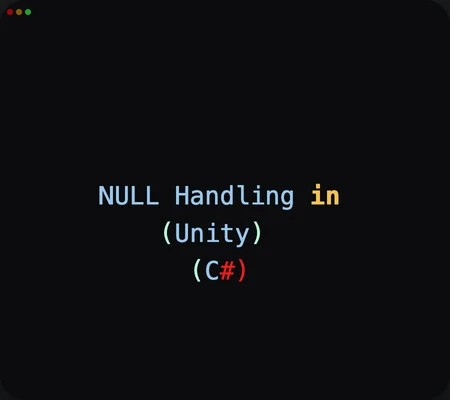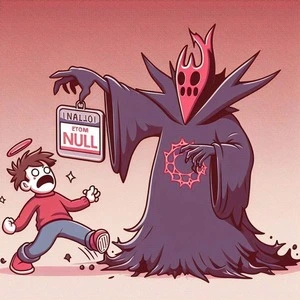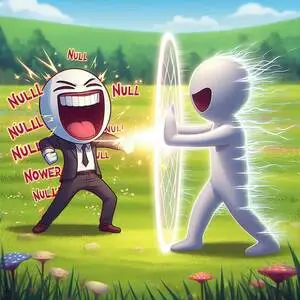Back To Home

Unity
3-04-2024
Don't Let Nulls Haunt Your Game: A Fun Look at Null Handling in C#
"Is your code haunted by the ghosts of uninitialized variables? Do you hear them whispering 'null... null... null...' in the dead of night? Don't worry, it's not your imagination – it's null references wreaking havoc! But unlike the spooky stuff in movies, we can actually banish these nulls for good!"
Introduction :
-
In the world of programming, handling unexpected scenarios is crucial. One common challenge developers face is dealing with null values.
-
In C# null is a special value that indicates the absence of a meaningful value in a variable. It has the power to either make or break your code so in this blog post, we’ll explore what null is, how to handle it.
What is Null?
Null is essentially the absence of a value. It’s essentially a way of saying, “there’s nothing here.”, When a variable is assigned the value null, it means that the variable does not point to any object or data.
-
In C# and Unity, null is used to represent the absence of a reference to an object.
Null is the default value of reference type variables. Primitive data types like int ,char, float etc. can not store null into it until they are of nullable type.
string myString = null; // myString now holds no value

Dealing with Null:
Attempting to perform operations on a null value can lead to runtime errors, commonly known as NullReferenceException. This exception occurs when you try to access a member (a method or property) of an object that is currently null.
string myString = null;
int length = myString.Length; // NullReferenceException
if(myString == null)
{
Debug.Log("You had one job, variable! Hold a reference, that's it! But noooo...");
}
To avoid such errors, developers must implement strategies to handle null values gracefully.
Use conditional statements to check if a variable is null before accessing its members. This prevents NullReferenceException and ensures a smooth execution flow.
1. Null Checking :
if (myObject != null)
{
// Access members of myObject safely
}
In C# version 2.0, a significant feature was introduced called Nullable Types. Before this, certain types in C# (like integers, floats, and other value types) could not have a value of null. Nullable types provided a way to assign a null value to these types, indicating the absence of a meaningful value.
The introduction of nullable types allowed us to use the ? symbol after the type declaration to make it nullable. Now, myNullableNumber can hold either an integer value or null.
Nullable types are particularly useful when dealing with databases or situations where a value might be missing or unknown. For example, if you have a database column that can be empty, you could use a nullable type to represent that in your C# code.
In this example, databaseValue can either hold an integer or be null. The HasValue property is used to check if it has a value before trying to access it. If it doesn’t have a value, you can handle it gracefully.
2. Nullable Types :
Before Nullable Types (C# 1.0):
int myNumber = 10; // Valid
int anotherNumber = null; // Error - Cannot assign 'null' to an 'int'
With Nullable Types (C# 2.0):
int? myNullableNumber = null; // Nullable int
Why Use Nullable Types?
int? databaseValue = GetFromDatabase(); // GetFromDatabase() might return an int or null
if (databaseValue.HasValue)
{
int result = databaseValue.Value; // Access the value safely
}
else
{
Debug.Log("Value is null");
}
This operator helps you avoid a null reference exception when working with chained member access (properties or methods) on an object that might be null.
It allows you to access members of an object only if the object is not null.
If the object is null, the entire expression evaluates to null without throwing an exception.
Example :
3. Null Conditional Operator :
// Without null conditional operator
string length = (person != null && person.Address != null) ? person.Address.City : "Unknown";
// With null conditional operator
string length = person?.Address?.City ?? "Unknown";

This operator provides a default value when encountering a null value.
It’s used to simplify the syntax for handling null values by providing a default value if the expression on the left is null.
It returns the left operand if it’s not null, otherwise, it returns the right operand (default value).
Example :
In summary, the null conditional operator (?.) helps you safely navigate through potentially null object members, and the null coalescing operator (??) simplifies the handling of null values by providing a default value if the left operand is null.
4. Null Coalescing Operator (??):
// Without null coalescing operator
string city = (person != null && person.Address != null) ? person.Address.City : "Unknown";
// With null coalescing operator
string city = person?.Address?.City ?? "Unknown";
It is a static method that belongs to the string class and is used to check whether a string is either null or an empty string (“”).
Example :
5. IsNullOrEmpty :
string myString = "Hello, World!";
if (string.IsNullOrEmpty(myString))
{
Debug.Log("The string is either null or empty.");
}
else
{
Debug.Log("The string is not null and not empty.");
}
We can use it to check if an object is of a certain type or if it is null. The is operator returns true if the object is an instance of the specified type or false otherwise.
Example :
6. is operator :
GameObject myObject = // obtain a GameObject reference from somewhere
if (myObject is null)
{
Debug.LogError("Object not found? Is this a metaphor for my life?");
}
else
{
Debug.Log("The GameObject is not null.");
}
NullReferenceException:
Occurs when attempting to access members (properties, methods, or fields) of a null object.ArgumentNullException:
Thrown when a method is called with a null argument that is not allowed to be null.InvalidOperationException:
Can occur if an operation is performed on an object in an invalid state, often involving null references.
Common Null-Related Exceptions :
public void DoSomething(string input)
{
if (input == null)
{
throw new ArgumentNullException(nameof(input), "Input cannot be null.");
}
}
Handling Null in Unity :
In Unity , null can manifest in various scenarios, such as missing references to game objects or components. Proper handling is crucial to avoid crashes and unexpected behavior.
Missing Component Check :
Verify the existence of components before accessing or using them to prevent NullReferenceException.Unity’s Object Class :
Unity’s Object class provides the ReferenceEquals method for comparing objects, considering null as equal.
Rigidbody rb = GetComponent();
if (rb != null)
{
// Safely use the Rigidbody
}
if (ReferenceEquals(myObject, null))
{
// Handle the null case
Debug.Log("Tried to access a null object? That's a null-ive approach, my friend.");
}
By mastering null handling techniques, you'll create more robust and reliable C# and Unity projects. You'll spend less time debugging NullReferenceExceptions and more time crafting engaging game experiences. Remember, null doesn't have to be a nightmare – with the right tools and strategies, you can keep your code flowing smoothly.
I hope you found this blog post enjoyable!